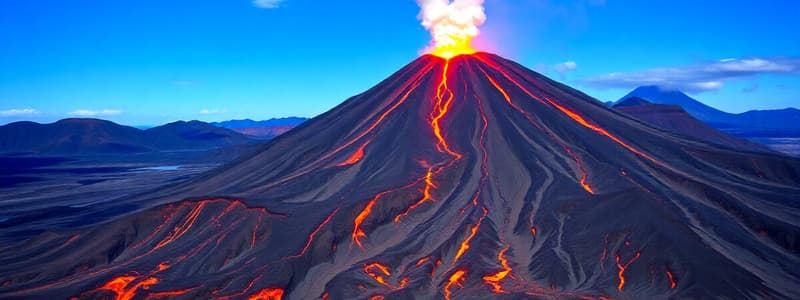Podcast
Questions and Answers
A volcano is observed to have frequent, gentle eruptions with lava flowing smoothly. Based on the eruption type classification, which type of eruption is most likely occurring?
A volcano is observed to have frequent, gentle eruptions with lava flowing smoothly. Based on the eruption type classification, which type of eruption is most likely occurring?
- Plinian Eruption
- Hawaiian Eruption (correct)
- Pelean Eruption
- Vulcanian Eruption
Mount St. Helens is known for its explosive eruptions and the production of viscous lava. Based on lava type, which category does Mount St. Helens most likely belong to?
Mount St. Helens is known for its explosive eruptions and the production of viscous lava. Based on lava type, which category does Mount St. Helens most likely belong to?
- Andesitic Volcanoes (correct)
- Composite Volcanoes
- Rhyolitic Volcanoes
- Basaltic Volcanoes
A volcanologist is studying a volcano that has not erupted in over 10,000 years and shows no signs of activity. How should the volcanologist classify this volcano based on its periodicity of eruption?
A volcanologist is studying a volcano that has not erupted in over 10,000 years and shows no signs of activity. How should the volcanologist classify this volcano based on its periodicity of eruption?
- Extinct Volcano (correct)
- Resting Volcano
- Active Volcano
- Dormant Volcano
During an eruption, a volcano ejects lava bombs and gas with mild explosions. Which type of eruption is most likely occurring?
During an eruption, a volcano ejects lava bombs and gas with mild explosions. Which type of eruption is most likely occurring?
Which type of eruption is characterized by extremely violent explosions, massive ash clouds, and pyroclastic flows?
Which type of eruption is characterized by extremely violent explosions, massive ash clouds, and pyroclastic flows?
A volcano is located underwater, and its eruptions are creating a new island. Which type of eruption is most likely at play?
A volcano is located underwater, and its eruptions are creating a new island. Which type of eruption is most likely at play?
Mount Vesuvius, which erupted in 79 AD, is a famous example of which type of eruption?
Mount Vesuvius, which erupted in 79 AD, is a famous example of which type of eruption?
Which type of volcano is characterized by low-viscosity lava that flows easily, forming broad, shield-like structures?
Which type of volcano is characterized by low-viscosity lava that flows easily, forming broad, shield-like structures?
Which of the following scenarios would most likely result in a Pelean eruption?
Which of the following scenarios would most likely result in a Pelean eruption?
Flashcards
Basaltic Volcanoes
Basaltic Volcanoes
Volcanoes that produce low-viscosity basaltic lava, which flows easily.
Andesitic Volcanoes
Andesitic Volcanoes
Volcanoes that erupt more viscous andesitic lava, leading to moderate explosions.
Rhyolitic Volcanoes
Rhyolitic Volcanoes
Volcanoes characterized by highly viscous lava, often causing explosive eruptions.
Hawaiian Eruption
Hawaiian Eruption
Signup and view all the flashcards
Strombolian Eruption
Strombolian Eruption
Signup and view all the flashcards
Vulcanian Eruption
Vulcanian Eruption
Signup and view all the flashcards
Active Volcano
Active Volcano
Signup and view all the flashcards
Dormant Volcano
Dormant Volcano
Signup and view all the flashcards
Extinct Volcano
Extinct Volcano
Signup and view all the flashcards
Study Notes
- Volcanoes classification depends on lava type, eruption style, and eruption frequency.
Based on Lava Type:
- Basaltic volcanoes produce low-viscosity basaltic lava, flowing easily as seen in shield volcanoes like Mauna Loa, Hawaii.
- Andesitic volcanoes erupt more viscous andesitic lava, causing moderate explosions, exemplified by Mount Fuji, Japan.
- Rhyolitic Volcanoes feature highly viscous lava, leading to explosive eruptions such as those of Yellowstone Caldera, USA.
Based on Eruption Type:
- Hawaiian eruptions are gentle, with lava flowing smoothly, common in shield volcanoes.
- Strombolian eruptions are mildly explosive, ejecting lava bombs and gas, like Stromboli, Italy.
- Vulcanian eruptions involve short, powerful bursts of ash, gas, and lava, such as Parícutin, Mexico.
- Plinian eruptions are extremely violent, producing massive ash clouds and pyroclastic flows; Mount Vesuvius in 79 AD is an example.
- Pelean eruptions cause deadly pyroclastic flows due to lava dome collapse, as seen in Mount Pelée, 1902.
- Surtseyan eruptions are underwater eruptions that can create new islands, such as Surtsey, Iceland.
Based on Periodicity of Eruption:
- Active volcanoes erupt frequently or show activity, like Mount Etna, Italy.
- Dormant volcanoes haven't erupted in a long time but may erupt again, such as Mount Kilimanjaro, Tanzania.
- Extinct volcanoes show no activity for thousands of years and are unlikely to erupt again, such as Mount Kenya, Kenya.
Studying That Suits You
Use AI to generate personalized quizzes and flashcards to suit your learning preferences.




